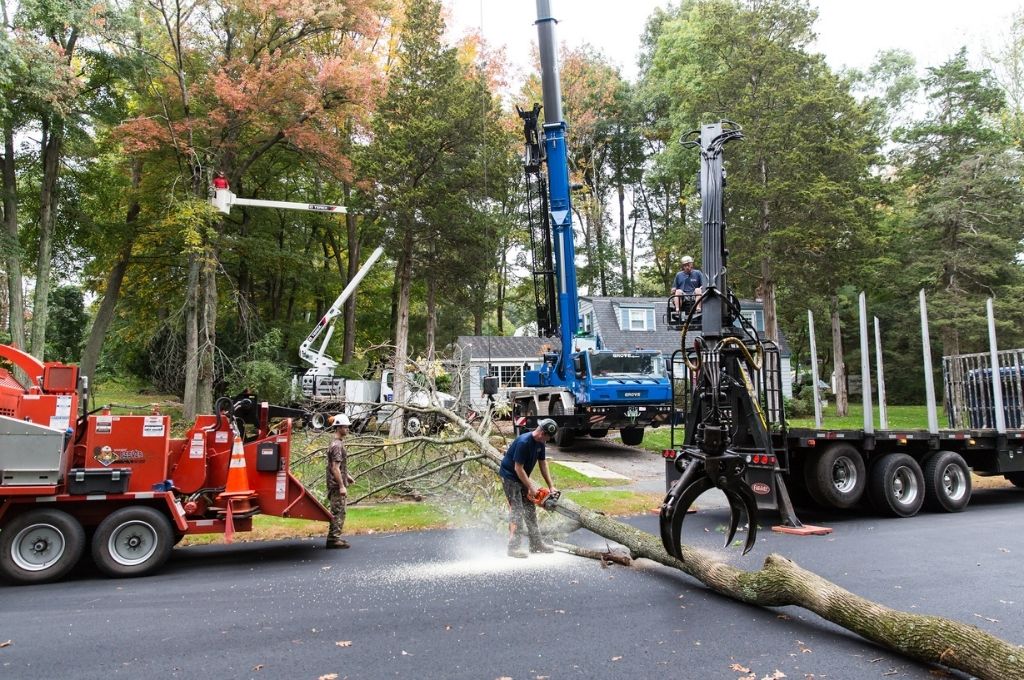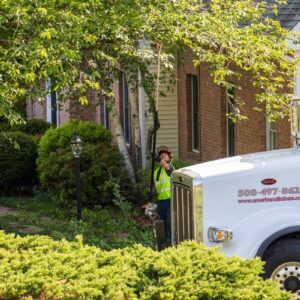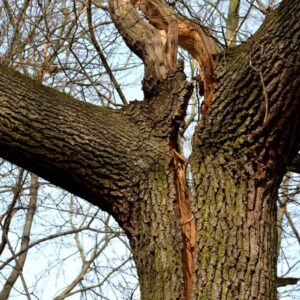When you decide it’s time to cut down a tree, there are some things you’ll need to do before tree removal starts, even if you’re cutting it down yourself. Learn how to prepare for tree removal work, when it should be done, and why proper preparation is critical for safely taking down a tree.

#1 – Evaluate the Tree
Whether you inspect the tree yourself or call in a tree care professional, a thorough evaluation is a critical first step. The best (and safest!) tree removal method will depend on the condition and location of the tree so skipping this step puts everyone at risk.
Look for things like:
-
- How large is the tree?
- What species of tree is it?
- Is the tree dead? (dead trees are more dangerous to remove)
- Is it damaged, decayed, diseased, or structurally defective in any way?
- Are there powerlines in or near the tree? You may need to have the utility company cut power or disconnect the lines during tree removal. (what you need to know about removing trees near power lines)
- Are there structures, traffic, or people within reach of the tree if it were to fall?
- How easily can it be accessed with heavy equipment, such as a crane or bucket truck?
- Is the tree on your property? (You’d be surprised how many people don’t check this first and then find that they’ve cut down their neighbor’s tree or, worse yet, the city’s tree!)
- Do you need a permit to cut down the tree?
Do you need to get rid of a tree in a confined space? See How to Remove a Tree in Confined Spaces
Do you need to get rid of a pine tree? See Pine Tree Removal In Massachusetts
Do you need to get rid of a dead ash tree? See Dead Ash Tree Removal

Remove any lawn furniture, potted plants, toys, etc. from the area before tree removal.
#2 – Protect What’s Around Your Tree
After the tree has been fully inspected and you or the tree service company have decided on the best way to remove it, it’s time to consider its surroundings. Without adequate protection, falling trees and heavy equipment can cause extensive damage to your landscape and nearby structures.
Depending on where a tree is located, you should protect or remove:
- Nearby trees and shrubs
- Fences, arbors, pergolas, and other structures
- Paved patios or paths
- Outdoor furniture
- Potted plants
- Neighboring property and trees
- Pets and family
And depending on the time of year that your tree is removed, there may be additional considerations, such as:
- Overhead power lines in icy winter weather
- Nesting, migratory birds in spring
In short, move anything of value away from the tree’s vicinity and from the staging areas for green waste and wood chipping. A falling tree limb can cause serious damage and even death.
And if there are any valuable landscape plants or other trees nearby, follow these tips to prevent damage to branches, trunks, and roots.

#3 – Make A Staging Area Plan for Tree Removal
Trees are often much bigger than people think. It’s difficult for most people to look at a tree and envision just how much space it would take up if it were lying on the ground. Just know that you’ll need a lot of space to place leafy branches as they’re cut off, plenty of room as they’re dragged to the chipper, and parking areas for any heavy equipment.
The equipment that makes tree removal safe and efficient is big! And it’s your responsibility to make sure there’s enough room for all of that equipment. Depending on the size, location, and condition of your tree, you can expect to see equipment such as:
- Bucket truck or crane to reach the tree and remove green waste
- Wood chipper for green waste and mulch
- Stump grinder to remove the stump
- Crew trucks for safety gear and tools
When removing a tree, you’ll want cranes and bucket trucks as close as possible to the tree. That means having them on your lawn, driveway, or on the street. You’ll also want the woodchipper conveniently located to reduce the distance crews have to haul branches and sections of the trunk – all while still allowing them plenty of room to safely feed green waste into the chipper.

Be a good neighbor, let your neighbors know beforehand that you have a tree removal scheduled.
#4 – Inform Your Neighbors
An important part of tree removal planning is neighborliness. The noise and disruption from tree removal can be unbearable for some people. Be sure you give your neighbors plenty of notice before tree work commences, particularly if:
- your tree is encroaching onto their property
- their trees encroach onto yours and risk being damaged during tree work
- crews need access to your neighbor’s property to access your tree or to clean up green waste
- trucks and equipment will take up parking spaces generally used by your neighbors
Even if you have installed temporary no-parking signs before the morning when tree removal starts, it’s a good idea to give people plenty of notice. Cooperation is key to ensuring a smooth tree removal, particularly in dense neighborhoods where parking and access are scarce, and in suburban areas where people value their peace and quiet.
Need a Hand?
A thorough tree inspection, well-laid-out staging area, protected surroundings, and professional crews make for faster, safer tree removal with minimal disturbance. Given the many risks involved in cutting down a tree, as well as the preparation needed to do it safely, we always recommend that home and business owners hire a fully insured, experienced, tree removal service. After 25+ years in the tree removal business, the American Climbers team is your best choice for tree removal in Hopkinton and surrounding areas of metro-west Massachusetts. Give us a call today for a free quote!
Blog Topics
Recent Posts
What's Happening? Stay Informed!
Stay on top of local events, pest and disease updates, tree and landscape tips, and more. Delivered straight to your inbox each month.






